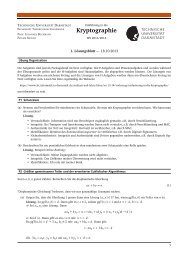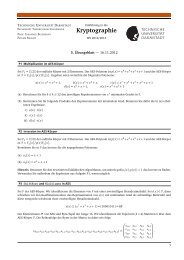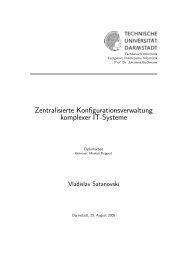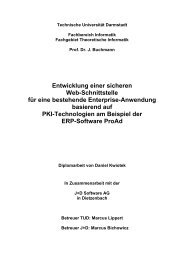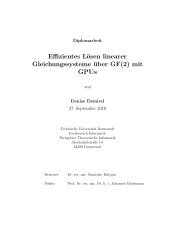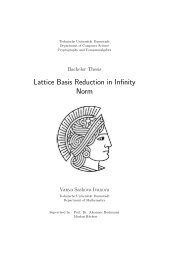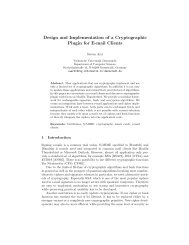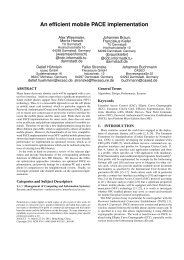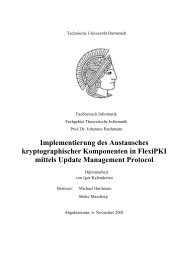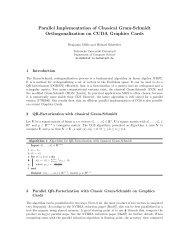Merkle Tree Traversal Techniques - CDC
Merkle Tree Traversal Techniques - CDC
Merkle Tree Traversal Techniques - CDC
Create successful ePaper yourself
Turn your PDF publications into a flip-book with our unique Google optimized e-Paper software.
the two children values first. In the second case we continue adding leaf values until we<br />
reach the first case. The intermediate values stored in the stack during the execution of<br />
the algorithm are called tail node values and create the tail of the stack. This simple<br />
H + 1<br />
implementation is very effective, because for the total of 2 − 1 rounds (one for each<br />
H<br />
node) it requires a maximum of 2 −1computational units for a <strong>Merkle</strong> tree of maximal<br />
height H . In this number are included the calculations of the leaf values which are done<br />
by an oracle LEAFCALC (hash computations and LEAFCALC computations are counted<br />
equally). In the algorithm the leaf indexes are denoted by leaf which is incremented<br />
every round. So LEAFCALC ( leaf ) is simply the value of the leaf with index leaf .<br />
Another important thing about the algorithm is that it stores a maximum of H + 1 hash<br />
values every round, thus conserving space. This is because node values are discarded<br />
when they are not needed any more, which is after their parent value is calculated. Now<br />
we present the algorithm itself:<br />
Algorithm 2.1: TREEHASH (start, maxheight)<br />
1 Set leaf = start and create empty stack.<br />
2 Consolidate: If top 2 nodes on the stack are equal height:<br />
• Pop node value Pn ( right ) from stack.<br />
• Pop node value P( n left ) from stack.<br />
⎛ ⎞<br />
• Compute Pn ( parent ) = f ⎜<br />
⎜Pn ( left) Pn ( right ) ⎟<br />
⎜⎝<br />
⎟<br />
⎠⎟<br />
.<br />
Pn = , output ( parent )<br />
• If height of ( parent ) maxheight<br />
• Push Pn ( parent ) onto the stack and stop.<br />
3 New Leaf: Otherwise:<br />
• Compute Pn ( l ) = LEAFCALC ( leaf ) .<br />
• Push Pn ( l ) onto the stack.<br />
• Increment leaf .<br />
4 Loop to step 2.<br />
15<br />
Pn .<br />
In most cases we need to implement the TREEHASH algorithm into the traversal<br />
algorithms themselves, which means into bigger algorithms. This is possible by defining<br />
an object with two methods. The first method is called initialize and it simply sets which<br />
leaf we start the TREEHASH with, and what the height of the desired output is. For<br />
example later we will meet the following statement - Stackh. initialize( startnode, h )<br />
which tells us that we will modify the Stack h stack starting with the leaf of index<br />
startnode and going up to height h ( h≤ H ). The second method is called update and it





